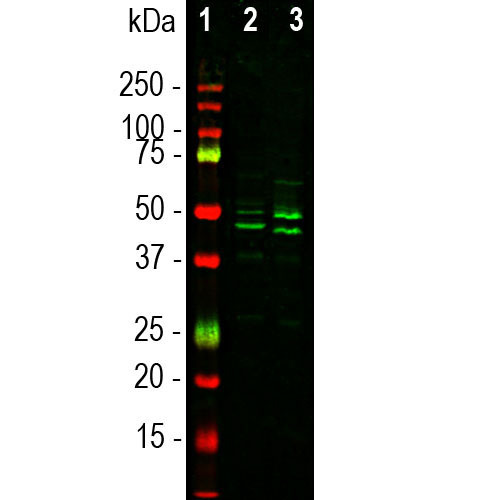| Name: | Goat Polyclonal to Fox3/NeuN |
| Immunogen: | N-terminal 100 amino acids of human Fox3 expressed in and purified from E. coli |
| HGNC Name: | RBFOX3 |
| UniProt: | A6NFN3 |
| Molecular Weight: | 46, 48kDa |
| Host: | Goat |
| Isotype: | |
| Species Cross-Reactivity: | Human, rat, mouse |
| RRID: | AB_2858263 |
| Format: | Affinity purified antibody at 1mg/mL in 50% PBS, 50% glycerol plus 5mM NaN3 |
| Applications: | WB, ICC/IF, IHC |
| Recommended Dilutions: | Western blot: 1:1,000-1:2,000. IF/IHC 1:1000-1:5,000 |
| Storage: | Store at 4°C for short term, for longer term at -20°C |

Immunofluorescent analysis of a section of adult rat hippocampus stained with goat pAb to Fox3/NeuN, GPCA-FOX3, dilution 1:2,000 in red, costained with mouse monoclonal antibdy to MAP2 MCA-4H5, dilution 1:2,000, in green. Nuclear DNA was revealed in blue using the DAPI stain. Following transcardial perfusion of mouse with 4% paraformaldehyde, brain was post fixed for 24 hours, cut to 45μM, and free-floating sections were stained with the above antibodies. The Fox3/NeuN antibody stains the nuclei of neurons in the hippocampus while the MAP2 antibody stains the dendritic processes of neurons.

Western blot analysis of whole brain lysates using goat pAb to FOX3/NeuN, GPCA-FOX3, dilution 1:1,000 in green: [1] protein standard (red), [2] mouse brain, [3] rat brain. Bands at 46k and 48 kDa correspond to protein isotypes of FOX3/NeuN.
Goat Polyclonal Antibody to FOX3/NeuN
Cat# GPCA-FOX3
$150.00 – $1,000.00
In the early 90s an unusual protocol resulted in the raising of a mouse monoclonal antibody against a component of neuronal nuclei and proximal perikarya (1). The component was therefore named “NeuN” and was shown to correspond to two protein bands at 46 and 48kDa in SDS-PAGE blots. The antibody become very widely used as a reliable neuronal marker, apparently binding to neurons in all vertebrates tested. The vast majority of neurons are strongly NeuN positive, and NeuN immunoreactivity has therefore been widely used to identify neurons. The identity of the NeuN protein was however unknown until 2009 when Kim et al. (2) showed that it was identical to FOX3, a mammalian homolog of a gene product originally identified in Caenorhabditis elegans and named FOX1 (2,3). There are three mammalian FOX1 protein homologs, FOX1, FOX2 and FOX3, which are believed to have a role in the regulation of mRNA splicing (4). All three contain an almost identical central RNA recognition motif or RRM domain, a region of about 90 amino acids found in numerous proteins. The differing protein isoforms of FOX3 result from alternate splicing of two exons which code for an insert close to the C-terminus and a short C-terminal extension (5). The extension includes a C-terminal proline-tyrosine sequence preceded by hydrophobic amino acids (Φ-PY) which is known to target proteins to the nucleus, apparently accounting for FOX3 being present in both nuclei and cytoplasm in certain neurons (5).
The GPCA-FOX3 antibody was raised against a recombinant human FOX3 construct based only on the N-terminal sequence, not including the RRM domain and C-terminal regions. The N-terminal regions of FOX1, FOX2 and FOX3 are relatively poorly conserved so we were able to obtain antibodies which recognized FOX3 but not FOX2 or FOX1. As a result the epitopes for GPCA-FOX3 are known to be within this construct, specifically amino acids 1-99. We used the same immunogen to generate chicken polyclonal and mouse monoclonal antibodies to FOX3, CPCA-FOX3 and MCA-1B7 respectively. We also generated rabbit polyclonal antibody, RPCA-FOX3, against peptide corresponding to amino acids 5-24 of human FOX3 coupled to KLH. All these FOX3/NeuN antibodies can be used to quantify the neuron/glial ratio in primary cell culture or tissue sections from different species. Mouse select image above left for larger view.
Chromogenic immunostaining of a formalin fixed paraffin embedded rat hippocampus section with goat pAb to FOX3/NeuN, GPCA-FOX3, dilution 1:2,000, detected with DAB (brown) using the Vector Elite ABC-HRP detection and reagents with citra buffer retrieval. Hematoxylin (blue) was used as the counterstain. The FOX3/NeuN antibody labels the nuclei of neurons in the hippocampus. Mouse select image for larger view.
1. Hodgkin J, Zellan JD, Albertson DG. Identification of a candidate primary sex determination locus, fox-1, on the X chromosome of Caenorhabditis elegans. Development 120:3681-3689 (1994).
2. Mullen RJ, Buck CR, Smith AM. NeuN, a neuronal specific nuclear protein in vertebrates. Development 116:201-211 (1994).
3. Herculano-Houzel S, Lent R. Isotropic fractionator: a simple, rapid method for the quantification of total cell and neuron numbers in the brain. J Neurosci. 25:2518-2521 (2005).
4. Kim KK, Adelstein RS, Kawamoto S. Identification of neuronal nuclei (NeuN) as Fox-3, a new member of the Fox-1 gene family of splicing factors. J. Biol. Chem. 284:31052-31061 (2009).
5. Underwood,J.G., Boutz,P.L., Dougherty,J.D., Stoilov,P. and Black,D.L. Homologues of the Caenorhabditis elegans Fox-1 protein are neuronal splicing regulators in mammals. Mol. Cell. Biol. 25:10005-10016 (2005).
Related products
-

Mouse Monoclonal Antibody to β-tubulin
$120.00 – $800.00
Cat# MCA-1B12Select options This product has multiple variants. The options may be chosen on the product page -

Mouse Monoclonal Antibody to GAP43
$120.00 – $800.00
Cat# MCA-3H14Select options This product has multiple variants. The options may be chosen on the product page -

Rabbit Polyclonal Antibody to NF-H
$120.00 – $800.00
Cat# RPCA-NF-HSelect options This product has multiple variants. The options may be chosen on the product page -

Mouse Monoclonal Antibody to Human Ki67, Ki-67
$120.00 – $800.00
Cat# MCA-6B4Select options This product has multiple variants. The options may be chosen on the product page
Contact info
EnCor Biotechnology Inc.
4949 SW 41st Boulevard, Ste 40
Gainesville
Florida 32608 USA
Phone: (352) 372 7022
Fax: (352) 372 7066
E-mail: [email protected]



